 English
English
Jabra Sanitary is a sanitaryware supplier offering toilets, sinks, faucets, bathtubs, etc., at competitive prices. If you're a distributor, wholesaler, or project contractor, get a quote today!
 $23.9 Limited-time Offer
$23.9 Limited-time Offer Consignment Policy
Consignment Policy 20 Years of Experience
20 Years of Experience
When designing your kitchen, choosing the right sink is crucial for both function and style. A kitchen sink isn't just a utility feature. It's a centerpiece that affects your daily tasks, from washing dishes to food prep.
Let's examine the various types of kitchen sinks based on installation methods, bowl numbers, shapes, and materials. Then you will find what type of kitchen sink is best for you.
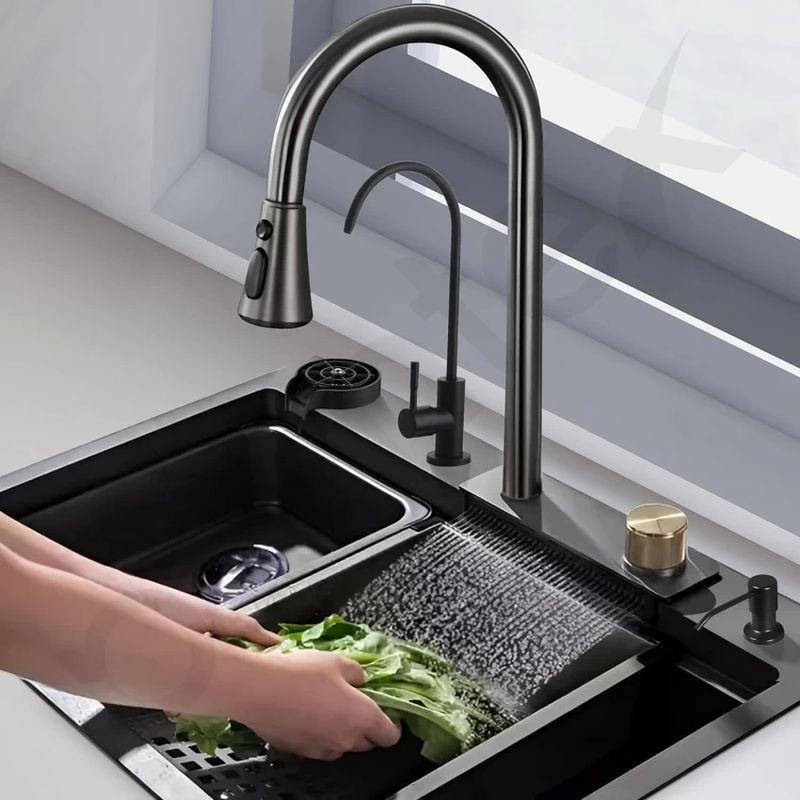
Table of Contents
Kitchen Sink Types By Installation Method
Kitchen Sink Types By Bowl Numbers
Popular Kitchen Sink Styles
Kitchen Sink Types By Shape
Kitchen Sink Types By Material
Important Factors to Consider When Choosing a Kitchen Sink
How to Clean and Maintain a Kitchen Sink?
FAQs
Final Words: Which Kitchen Sink Type is Right For You?
Kitchen Sink Types By Installation Method
When choosing a kitchen sink, one of the first decisions you'll need to make is how the sink will be installed. The installation method can greatly impact the look and functionality of your kitchen.
Below, we'll explore the different kinds of kitchen sinks based on their installation methods.
Undermount Sink
An undermount sink is installed underneath the countertop, giving it a clean, modern look. This installation method hides the edges of the sink, creating a seamless transition between the sink and the countertop.
It's ideal for materials like granite, marble, or quartz, as it lets you easily wipe crumbs and water directly into the sink.
Drop-In/Top-Mount Sink
A drop-in sink, also known as a top-mount sink, is the most traditional installation type. The sink is installed by dropping it into a cut-out hole in the countertop.
The rim of the sink rests on the countertop, making the installation process relatively easy.
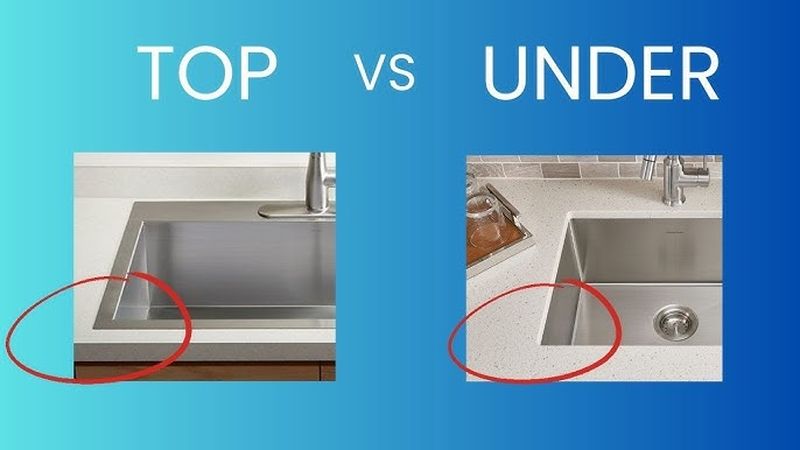
Integrated Sink
Integrated sinks are built directly into the countertop, meaning the sink and the counter are made from the same material, typically stone or solid surface. This creates a seamless look with no visible seams or edges.
Farmhouse/Apron Sinks
Farmhouse sinks can be mounted in three different ways.
- Top Mount Sinks: They're the easiest to install. There's a flange that sits on the countertop just like a regular sink. They can be installed on any type of counter surface.
- Flush Mount Sinks: They sit even with the top of the counter. They typically require a solid surface or custom-made laminate top.
- Undermount Sinks: These sinks sit completely underneath the counter. They require a waterproof top that's custom cut for the sink and faucet.
Each of these installation methods has its advantages, so it's important to choose the one that best fits your kitchen's style, functionality, and your personal preferences.
Consider the countertop material, your budget, and how much maintenance you're willing to do when deciding which installation type works best for you.
Kitchen Sink Types By Bowl Numbers
When it comes to kitchen sinks, one important factor to consider is the number of bowls you need. The bowl count determines how well the sink accommodates various tasks like washing dishes, prepping food, and cleaning.
Let's examine the different kitchen sink types based on their bowl numbers:
Single Bowl Sink
The single-bowl sink is a classic choice for small kitchens or those with limited counter space.
This type of sink features a large, single basin that can be used for washing dishes, soaking pots, or preparing food. While it may not have the multitasking capability of multiple bowls, it offers simplicity and flexibility.
Best for:
Single-dwelling households, apartments, or smaller kitchens where space is a concern.
Double Bowl Sink
The double bowl sink is a popular choice for busy kitchens. It features two separate basins, typically of equal or varying sizes.
The added bowl allows for multitasking, such as washing dishes on one side and rinsing or soaking on the other. This setup is a great choice for families or those who cook and entertain often.
Best for:
Larger kitchens or families who do a lot of cooking and dishwashing.
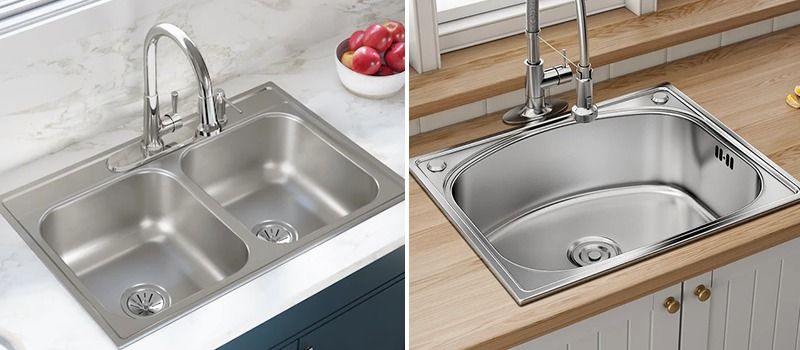
Low Divider Double Basin Sink
The low divider double basin sink is similar to the traditional double bowl sink but with a shorter, lower divider between the two bowls.
This design makes it easier to fit larger items like baking sheets or pots into either basin, while still giving the flexibility of two separate spaces.
Best for:
Home cooks who want the benefits of a double bowl but need extra space for larger items.
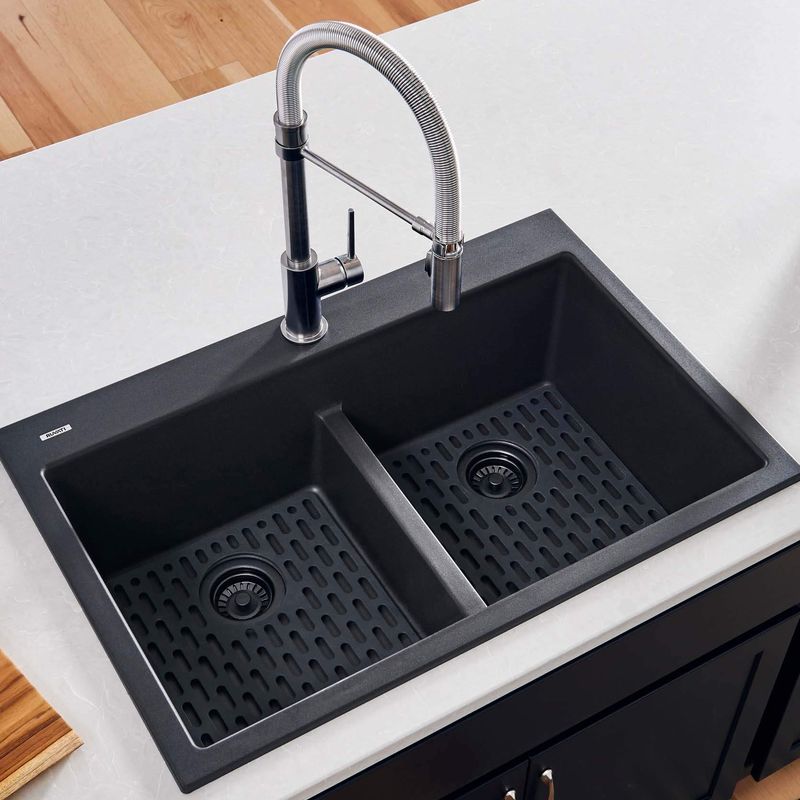
Three-bowl Sink
For those who want to go all-in on multitasking, the three-bowl sink is a great option. This type of sink comes with three separate bowls, often including a smaller side for rinsing or draining and two larger sections for washing and soaking.
While not as common as the other options, three-bowl sinks are perfect for heavy-duty kitchens with lots of cooking and dishwashing demands.
Best for:
Large kitchens, multi-cook households, or those who frequently host large gatherings and need ample space for cleaning and prepping.
Sink with Draining Board
A sink with a draining board incorporates a built-in area on one side of the sink where you can place washed dishes to drain. This type of sink is often seen in traditional or European kitchens.
It is a practical choice for people who prefer to air-dry their dishes or have a dedicated area to place freshly washed items.
Best for:
Traditional kitchens or those looking for a combination of utility and style.
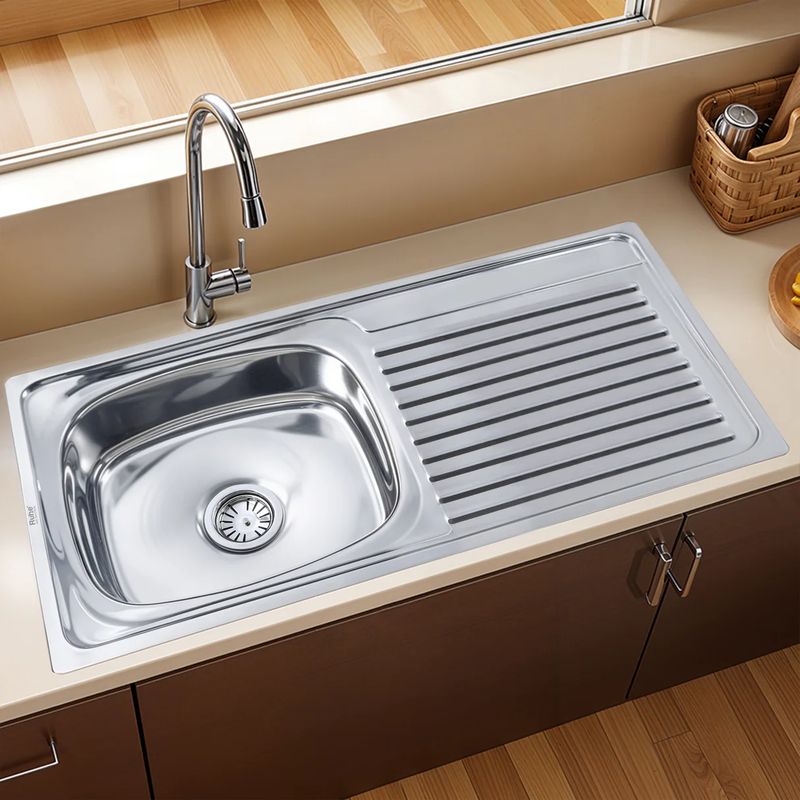
Popular Kitchen Sink Styles
When selecting a kitchen sink, the kitchen sink styles can make a significant difference not only in functionality but also in the aesthetic appeal of your kitchen.
Let's explore two popular kitchen sink styles: Bar, Island, or Prep Sink and the Corner Sink.
Bar, Island, or Prep Sink
The bar, island, or prep sink is a versatile and often smaller sink used in various parts of the kitchen.
These sinks are usually installed in an island or a separate bar area to complement the main kitchen sink. Their primary purpose is to provide an additional space for food preparation, beverage prep, or as a second sink for washing hands or dishes.
Best for:
- Kitchens with islands or open layouts that require an additional work area.
- Homeowners who enjoy cooking and entertaining, as it provides a separate area for prep work.

Corner Sink
The corner sink is installed in the corner of the kitchen, utilizing otherwise unused space. This style is ideal for small or oddly shaped kitchens where maximizing every inch of space is essential.
It can be a single or double bowl sink, offering a functional and space-saving solution.
Best for:
- Smaller kitchens or kitchens with unusual layouts.
- Homeowners who want to save space while maintaining a practical sink setup.
Choosing between these popular kitchen sink styles ultimately depends on your kitchen's layout, design preferences, and how much space you have to work with.
Kitchen Sink Types By Shape
The right kitchen sink shape can elevate the look of your kitchen while ensuring that the sink meets your everyday needs. Let's take a look at some popular kitchen sink shapes:
Round Sink
Round sinks are known for their smooth, elegant curves, making them a popular choice for modern and contemporary kitchens. The round shape provides a spacious bowl, which can be useful for tasks such as washing large pots and pans. Their sleek design also blends well with a variety of countertop materials, making them a versatile choice for many kitchen styles.
Best For:
- Small to medium-sized kitchens
- Homeowners who want a unique, modern touch to their kitchen design
- Those looking for easy-to-clean, efficient sinks
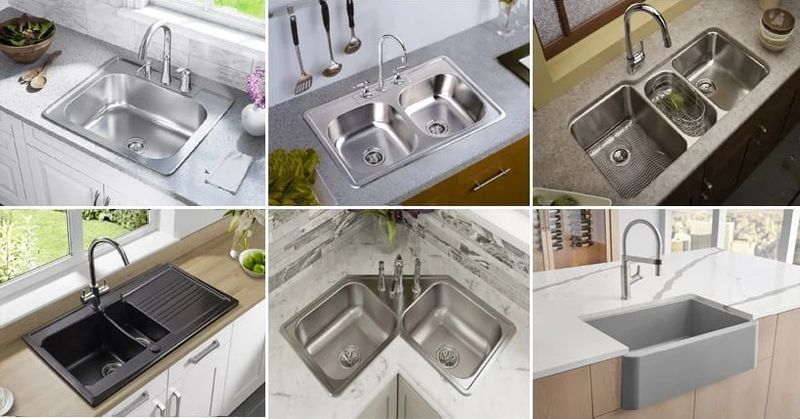
Square Sink
Square sinks are a favorite for those who prefer a more geometric, structured look in their kitchens. With sharp angles and clean lines, square sinks offer a contemporary, bold style.
They also tend to offer more usable space compared to their round counterparts, making them ideal for those who need extra room for large pots, pans, or stacks of dishes.
Best For:
- Larger kitchens or those requiring a spacious sink
- Homeowners who prefer a sharp, modern, and sleek design
- People who regularly wash large cookware
Kitchen Sink Types By Material
Choosing the right material for your kitchen sink is just as important as the sink's size or installation method.
The material not only influences the sink's durability and maintenance but also its look and feel. Below are the most popular materials used for kitchen sinks:
Stainless Steel Sinks
Stainless steel is one of the most common materials for kitchen sinks. It's durable, resistant to stains, and easy to clean.
Stainless steel sinks come in a variety of finishes—from brushed to polished—allowing you to find one that matches your kitchen's style.
Fireclay Sinks
Fireclay sinks are made from clay that's fired at extremely high temperatures. They are known for their smooth, glossy finish and timeless appeal, often found in farmhouse-style kitchens.
Acrylic Sinks
Acrylic sinks are made from molded plastic and come in a variety of shapes and colors. These sinks are lightweight, affordable, and come in different styles to match modern kitchens.
Copper Sinks
Copper sinks add a rustic or antique feel to your kitchen. They're unique, and stylish, and can be a conversation starter in your space.
Copper has a distinctive patina that changes over time, which only adds to its charm.
Solid Surface Sinks
Solid surface sinks, made from a blend of acrylic, resin, and minerals, are gaining popularity for their seamless look and easy maintenance.
These sinks can be custom-designed to match the countertops, creating a uniform and sleek appearance.
Granite Quartz Composite Sinks
Granite quartz composite sinks are a popular choice for modern kitchens. Made from a blend of crushed granite and acrylic resins, these sinks combine the look of natural stone with the durability of synthetic materials.
In conclusion, selecting the right material for your kitchen sink depends on a variety of factors such as durability, cost, style, and maintenance requirements. Think about your kitchen's design, how much use the sink will get, and your budget to make the best choice for your home.

Important Factors to Consider When Choosing a Kitchen Sink
Choosing the right kitchen sink involves more than just picking one that looks good. Several practical factors must be taken into account to ensure the sink you choose fits your lifestyle, kitchen space, and budget. Here are the key factors to consider:
Kitchen Sink Size
The size of your kitchen sink can impact both its functionality and the overall kitchen design. Single-bowl sinks are ideal for small kitchens where space is limited.
They provide enough space for basic kitchen tasks without taking up too much room.
Sink Depth
Sink depth refers to how deep the bowl of your sink is. This is an important factor to consider because it affects your ability to handle large pots or messy tasks like washing dishes or vegetables.
The most common depth for kitchen sinks is between 18 cm and 22 cm.

Faucet Compatibility and Number of Holes Required
Most kitchen sinks are designed to accommodate faucets with multiple holes, usually between one to four. These holes are used for the faucet itself, as well as additional features like a soap dispenser, water filter, or sprayer.
- One-Hole Sinks: Suitable for modern, sleek designs with a single faucet.
- Multiple Hole Sinks: Ideal if you want to add additional features like a soap dispenser or a pull-out sprayer.
Location of the Drain
The location of the drain can have a huge impact on how efficiently your sink functions. While most sinks have a centered drain, some feature off-center drains or even dual drains for split tasks.
Choosing the right location will depend on how you intend to use your sink.
Sink Materials and Weight
The material of your sink plays a huge role in its durability, appearance, and maintenance. It can also affect the sink's weight.
- Stainless Steel: Lightweight, durable, and easy to maintain.
- Cast Iron: Known for its heavy weight and exceptional durability.
- Granite Composite: Offer a premium feel and is resistant to scratches, stains, and high temperatures.
Sink Features
Different sinks come with varying features that can enhance their functionality. Some sinks offer features such as:
- Built-in Draining Boards: Perfect for draining dishes or fruits after washing.
- Soundproofing: Some sinks come with soundproofing layers to reduce noise from running water or dishwashing.
- Extra Accessories: Some sinks include cutting boards, colanders, or soap dispensers to make kitchen tasks easier.
- The Latest Trends in Kitchen Sinks
Like any other home feature, kitchen sinks also evolve with the times. New trends include:
- Smart Sinks: Faucets with touchless technology and built-in sensors that save water and enhance convenience.
- Bold Colors and Finishes: Sinks in vibrant colors, matte finishes, and unique textures are becoming more popular, adding a personalized touch to kitchen designs.
- Eco-Friendly Materials: With sustainability becoming more important, eco-friendly sink materials like recycled stainless steel or compostable composite options are on the rise.
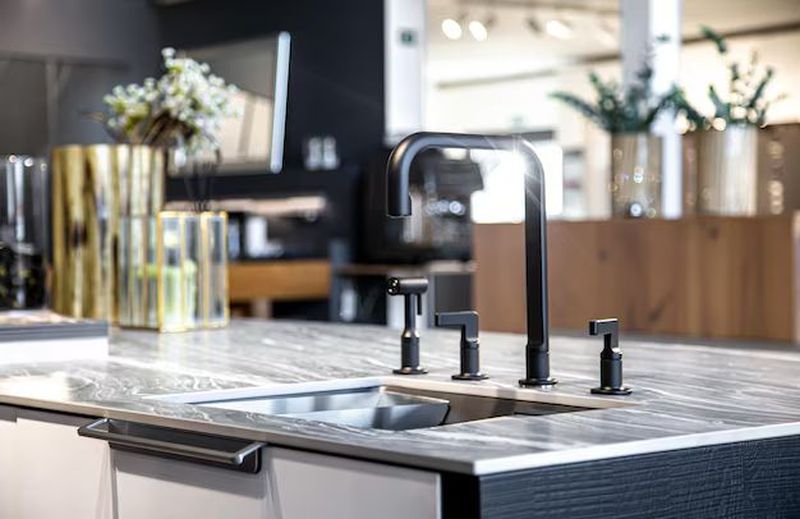
Installation and Maintenance
Installing a kitchen sink and keeping it in top shape requires careful attention. Depending on the installation method (undermount, drop-in, etc.), some sinks may require more work to install, especially if you're dealing with heavy materials like cast iron or stone.
- Ease of Installation: Drop-in sinks are easier to install, while undermount sinks may require professional installation.
- Maintenance: Some materials, like stainless steel, are low maintenance.Others, like fireclay, require more frequent care to maintain their appearance.
Your Budget
While it's tempting to splurge on the most luxurious sink, it's essential to balance quality with cost. Sinks can range from budget-friendly options to high-end designer sinks.
Consider how much you're willing to spend and what features are most important to you.
Where to Buy Your Kitchen Sink
Finally, where you purchase your kitchen sink is a crucial decision. Many options exist, from home improvement stores to specialty kitchen retailers and online platforms.
Prices, delivery times, and installation services can vary, so it's worth doing your research.
If you're looking to buy kitchen sinks in bulk, feel free to reach out to Jabra Sanitary. We are ready to assist you with quotations upon receiving your inquiry.
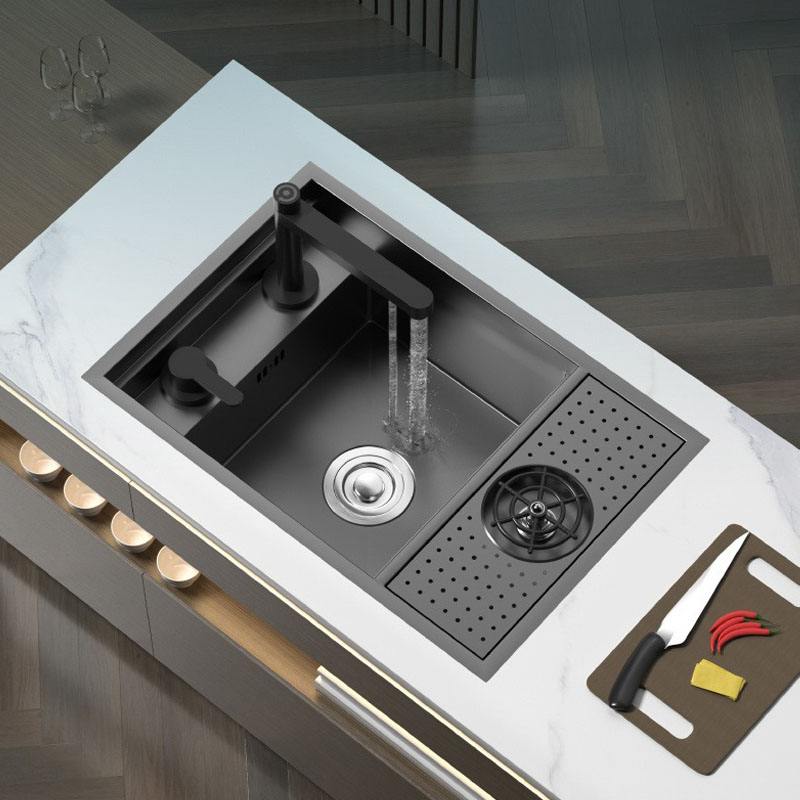
Undermount Double Bowl Workstation Sink
Here is the Undermount Double Bowl Workstation Sink H01, a versatile and functional addition to your kitchen. This double bowl workstation sink features a unique lifting faucet with dual hot and cold water outlets, easily adjustable to meet your needs without obstructing your workspace.
How to Clean and Maintain a Kitchen Sink?
A kitchen sink is one of the busiest areas in your home, handling everything from food prep to washing dishes. Proper care and maintenance can extend the life of your sink and keep it looking fresh and functional.
Here are some tips to help you clean and maintain your kitchen sink:
Rinse and Dry
After each use, it's a good habit to rinse your sink with warm water and dry it with a clean towel. This simple routine prevents water spots, soap scum, and mineral buildup, especially if you have hard water.
Keep a small dish towel or microfiber cloth near the sink to quickly dry it off after use.
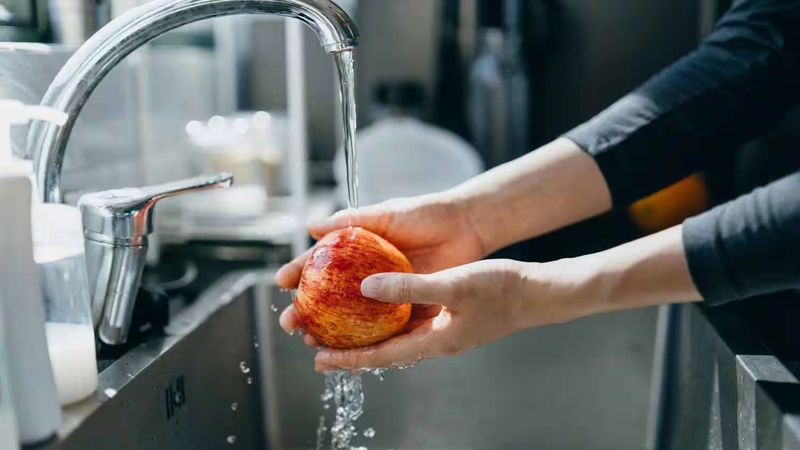
Clean
Cleaning your sink regularly is essential for hygiene and maintaining its appearance. Here are a few tips based on your sink's material:
- Stainless Steel: Use a mild dish soap or a dedicated stainless steel cleaner to scrub away grime. Avoid using abrasive sponges that could scratch the surface.
- Cast Iron or Fireclay: These sinks often have a glossy finish.So using a non-abrasive cleaner and a soft cloth will keep them in great shape. If stains appear, a baking soda and water paste can help lift them.
- Granite Composite: Clean with a soft sponge and gentle cleaner. Be sure not to use anything too harsh as it can damage the finish. Regularly wipe away food particles and soap scum.
- Acrylic and Solid Surface: Use a mild cleanser and a soft cloth or sponge. Avoid abrasive cleaners to prevent scratching.
Prevent Clogs
To keep your sink working efficiently, it's essential to prevent clogs in the drain. <Also learn how to unclog a kitchen sink>
Here are a few preventative measures:
- Use a Sink Strainer: A sink strainer can catch food particles, preventing them from going down the drain and causing clogs.
- Flush with Hot Water: Occasionally, run hot water through the drain to clear any buildup of grease, soap, or food particles.
- Avoid Pouring Grease Down the Sink: Grease can solidify in your pipes and create blockages. Instead, dispose of it in the trash.
Other Tips
- Descale Regularly: If you live in an area with hard water, you may notice mineral deposits forming on your sink. To remove these, use a vinegar solution (equal parts vinegar and water) and soak the affected area for 10–15 minutes before scrubbing.
- Polish the Sink: If your sink starts looking dull, polish it with a commercial sink polish or a mixture of baking soda and water. This will help restore its shine, especially on stainless steel sinks.
FAQs
When it comes to selecting and maintaining a kitchen sink, many homeowners have questions. Here are some of the most frequently asked questions to help guide you through the process:
Are stainless steel sinks outdated?
Stainless steel sinks are far from outdated! They remain one of the most popular choices for kitchens due to their durability, easy maintenance, and timeless look.
Stainless steel works well in both traditional and modern kitchens and is especially favored for its resistance to stains, heat, and corrosion.
What type of kitchen sink is most popular?
The most popular type of kitchen sink is the stainless steel sink, particularly the under-mount or drop-in varieties.
These sinks are favored for their sleek, minimalist look and ease of installation. Stainless steel is durable, versatile, and fits into a wide range of kitchen designs.
What is the easiest kitchen sink to install?
The easiest kitchen sink to install is typically the drop-in sink. This sink simply drops into a cutout in the countertop, making installation straightforward.
Drop-in sinks can be installed by most homeowners with some basic DIY skills.
Do you need a plumber to fit a kitchen sink?
While some homeowners can install a kitchen sink themselves, it's often a good idea to hire a plumber for professional installation, especially if you're working with complex plumbing or heavy materials like cast iron or granite.
A plumber can ensure everything is properly connected, preventing potential leaks or issues down the road.
Which is better, a single or double bowl kitchen sink?
The choice between a single-bowl and double bowl kitchen sink depends on your specific needs:
- Single Bowl Sink: Best for smaller kitchens or households that need more space for washing large pots and pans. It's also easier to clean and maintain.
- Double Bowl Sink: Ideal for larger kitchens where multiple tasks can be performed simultaneously, such as washing dishes in one bowl and rinsing in the other.
Final Words: Which Kitchen Sink Type is Right For You?
Choosing the perfect kitchen sink type requires finding a balance between practicality and aesthetics, while also considering the specific needs of your household.
Don't forget to ensure the cabinet supports the sink's weight before installation. Heavy materials like cast iron, fireclay, or granite require extra support to prevent damage to the cabinets. Don't overlook this step during installation to avoid any future issues.
Ready to choose your ideal kitchen sink style? Get in touch with Jabra sink manufacturer and let's help you find the perfect sink that fits your kitchen's needs! We're the experts in choosing the best type of kitchen sinks for you.





















